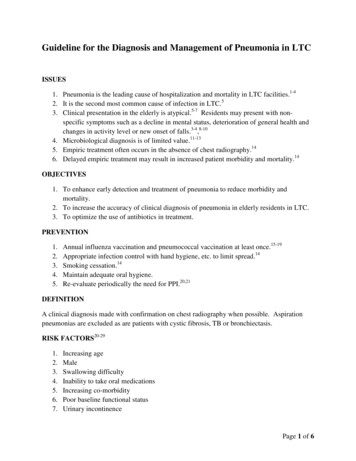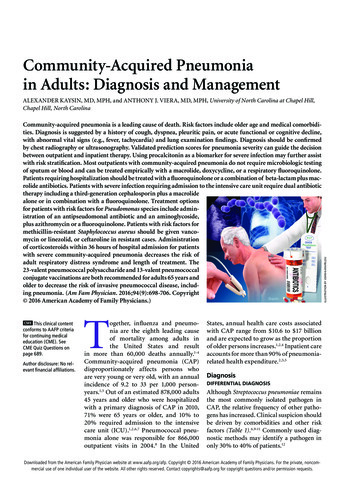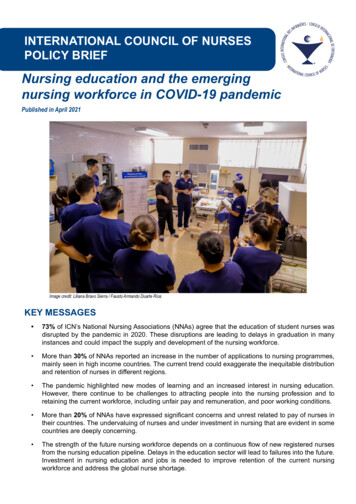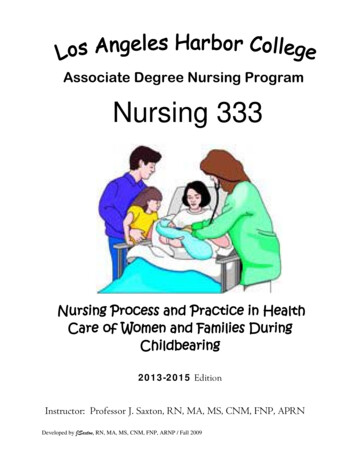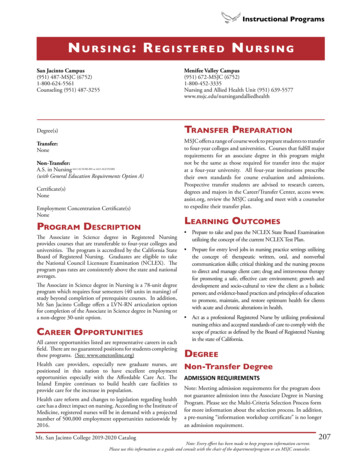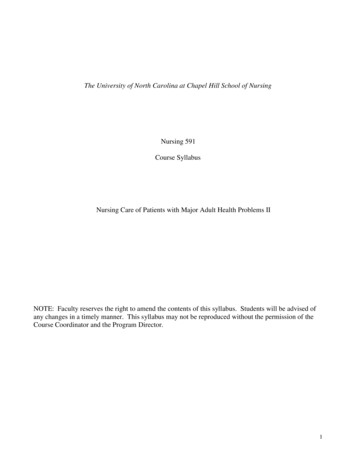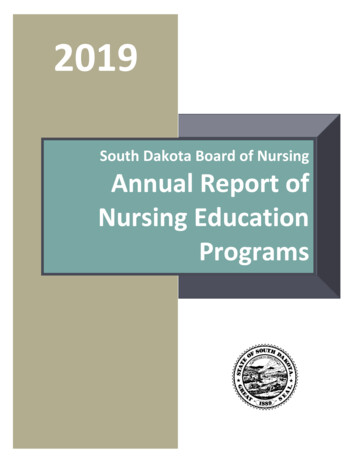
Transcription
Nursing Management of PneumoniaPathophysiology:Pneumonia can be caused by a variety of microorganisms that enter the airway and invade the alveolarspace.The infectious organisms multiply in the alveoli causing white blood cells (WBCs) to migrate to the area.This then causes capillary leak, edema, and exudate. Fluid then collects in and around the alveoli andcauses the alveolar walls to thicken. This causes decreased gas exchange and hypoxemia.Capillary leak can cause the infection to spread to other parts of the lung.Red blood cells (RBCs) and fibrin also migrate to the area of infection.The fibrin and edema also cause the lung to stiffen which decreases the lung’s vital capacity.The collapse of the alveoli (atelectasis) reduces the ability of the lung to oxygenate which results inhypoxemia.Pneumonia can occur as lobar pneumonia with consolidation in segments or as bronchopneumonia withdiffusely scattered patches.Pneumonia is also categorized into community-acquired or health care-acquired. This terminologysimply differentiates where the patient was exposed to the infectious agent that caused the pneumonia.Risk factors: Elderly patients are at higher riskPatients with a chronic health conditionAn older adult who has not received the pneumococcal vaccinationA patient who is on mechanical ventilationPatients who smoke cigarettesSigns & Symptoms:-Chest discomfortMyalgiaHeadacheChills due to infections processFever due to infectious processCoughCrackles, wheezing due to fluid accumulation and inflammation in the lungsTachycardiaDyspneathenursiversity.com
-TachypneaHemoptysisSputum productionAnxiety due to breathlessnessConfusion in older patients due to hypoxiaIncreased WBC due to infection processNursing Interventions:Educate patients on prevention of pneumonia--Patients over the age of 65 and those with chronic health conditions should be given thepneumococcal vaccine. Typically, only given once, but some individuals may be appropriate foranother vaccine after 5 years.Patients should also receive the flu vaccine yearly (because pneumonia often occurs afterinfluenza infection)Teach patients to avoid large crowds during cold and flu seasonTeach patients to perform strict handwashingEncourage patients who smoke to consider getting help to stop smokingEncourage patients to drink 2-3 L of nonalcoholic fluids every dayIf a patient is on a ventilator, then they are at increased risk of developing pneumonia- ventilatoracquired pneumonia (VAP). In order to prevent VAP, the “ventilator bundle” should be followed. Thebundle consists of-Hand hygieneOral careHead of bead elevationAdminister oxygen therapy to maintain oxygen saturation greater than 90%.Encourage patients to utilize incentive spirometry. Encourage them to attempt 5-10 breaths every hourwhile awake.Assist patients to turn, cough, and deep breathe every 2 hours.Encourage patients to drink 2 L of fluid every day.Administer prescribed bronchodilators by nebulizer.Administer prescribed inhaled or IV steroids for inflammation.Administer prescribed anti-infective. The anti-infective that is chosen will depend on the infective microorganism that caused the pneumonia.thenursiversity.com
Nursing Care Plan for PneumoniaIn this section, we will review potential nursing diagnoses and associated nursing interventions forpatients with pneumonia. The examples given are based upon what a “typical” patient with pneumoniamight look like. Be sure that when you are creating your nursing care plans that you individualize thenursing diagnoses and the “as evidenced by” to your patient. If you have any further questions aboutnursing care plans, you can check out my in-depth post about nursing care plans here.Nursing Diagnoses for Pneumonia:According to NANDA-I, the following are potential nursing diagnoses for a patient with pneumonia:-Activity IntoleranceIneffective Airway ClearanceImpaired Gas ExchangeIneffective Self-Health ManagementHyperthermiaDeficient KnowledgeImbalanced NutritionImpaired Oral Mucous MembraneRisk for Acute ConfusionRisk for Deficient Fluid VolumeRisk for Vascular TraumaReadiness for Enhanced Immunization StatusImpaired Gas Exchange r/t edema and inflammation in the alveoli AEB acute confusion, deceasedoxygen saturation on room air- 85%, need for 2L oxygen via nasal cannula, persistent cough, crackles x5,tachypnea, restlessnessGoal: Adequate Gas Exchange AEB A&O x4 (no confusion), oxygen saturation greater than 90% on roomair, absence of cough, lung sounds clear x5Nursing interventions:-The nurse will monitor the respiratory rate and depth and monitor for the use of accessorymuscles and nasal flaring (to identify worsening of dyspnea or tachypnea)The nurse will raise the HOB to 45 degrees throughout the shift (to promote lung expansion)The nurse will administer prescribed bronchodilators according the medication schedule (toopen airways)The nurse will encourage the patient to turn, cough, and deep breathe every 2 hours (topromote expansion of the lung and expectoration of any sputum)thenursiversity.com
-The nurse will encourage patient to utilize incentive spirometry every hour while awake (topromote lung expansion)The nurse will assess for cyanosis of the skin during each interaction with the patient (to identifyhypoxia)The nurse will encourage the patient to rest and conserve their energy (to prevent exacerbationsof dyspnea)Activity Intolerance r/t imbalance between oxygen supply and demand AEB tachypnea and dyspneaduring activities, oxygen saturation decreases during activity, patient reports “I get so tired so quickly”during activities of daily livingGoal: Activity Tolerance AEB breath rate between 10-20 respirations during activity, oxygen saturationremains about 90% during activity, patient does not report getting tired quickly during activities of dailyliving anymoreNursing interventions:-The nurse will encourage the patient to rest and conserve their energy (to prevent exacerbationsof dyspnea)The nurse will encourage the patient to use pursed-lip breathing during breathlessness thatoccurs during activity (to help decrease the severity of dyspnea)The nurse will monitor the patient’s respiratory response (rate, rhythm, depth) during activity(to assess for worsening or improvement of activity intolerance)The nurse will provide the patient with the prescribed amount of oxygen therapy during activityand continue to monitor the patient’s oxygen saturation throughout the activity (to ensureadequate oxygenation)Anxiety r/t breathlessness and dyspnea AEB wide-eyed looking during periods of difficulty breathing,restlessness, patient reports feelings of “anxiousness during times when I can’t seem to catch mybreath”, patient exhibits reluctance to participate in activities of daily living (such as bathing, range ofmotion activities, and ambulation) due to activity intoleranceGoal: Reduced Anxiety AEB a calmer look on the patient’s face during period of difficulty breathing,reduced restlessness, patient reports feeling less anxious during dyspnea, patient begins to participatein ADLsNursing interventions:-The nurse will assess the patient’s anxiety during periods of dyspnea. If possible, have thepatient rate their feelings of anxiety on a scale of 0-10.The nurse will utilize therapeutic communication and listening skills to allow the patient theability to express their feelings of anxiousness.The nurse will educate the patient on anxiety reducing interventions such as guided imagery,music therapy, aromatherapy, yoga etc.thenursiversity.com
NCLEX Style Questions for PneumoniaHere are a few NCLEX style questions for pneumonia to help you assess your comprehension of theinformation in this post. (These are NCLEX style questions that I created myself. I am not in any wayassociated with the NCLEX and have not been trained on how to write NCLEX style questions.)Which of the following statements would you include in patient education about pneumonia for a 70year-old male who has a chronic health condition? (Select All That Apply)A.B.C.D.E.The patient should avoid visiting family during cold and flu and seasonThe patient should drink 2-3 L of nonalcoholic fluids per dayThe patient should get the pneumococcal vaccine every yearThe patient should get the flu vaccine every yearThe patient should begin a smoking cessation programWhich of the following nursing diagnoses is the priority diagnoses that the nurse should implementnursing interventions for first?A.B.C.D.Deficient knowledgeImpaired gas exchangeHyperthermiaImbalanced nutritionA patient comes to the ER with the following signs and symptoms. Which of the following are notrelated to the primary diagnosis of pneumonia?A.B.C.D.E.Cough with sputum productionHematuriaFever of 100.9MyalgiaChest discomfortWhich patient is at the highest risk of developing pneumonia?A.B.C.D.A 3-year-old female with asthmaA 68-year-old male with a history of a chronic health conditionA 55-year-old female who is on a ventilator in the intensive care unit (ICU)A 40-year-old female with a history of hypertensionthenursiversity.com
Nursing Management of Pneumonia Pathophysiology: Pneumonia can be caused by a variety of microorganisms that enter the airway and invade the alveolar space. The infectious organisms multiply in the alveoli causing white blood cells (WBCs) to migrate to the area. This then causes capillary leak, edema, and exudate. Fluid then collects in and around the alveoli and
